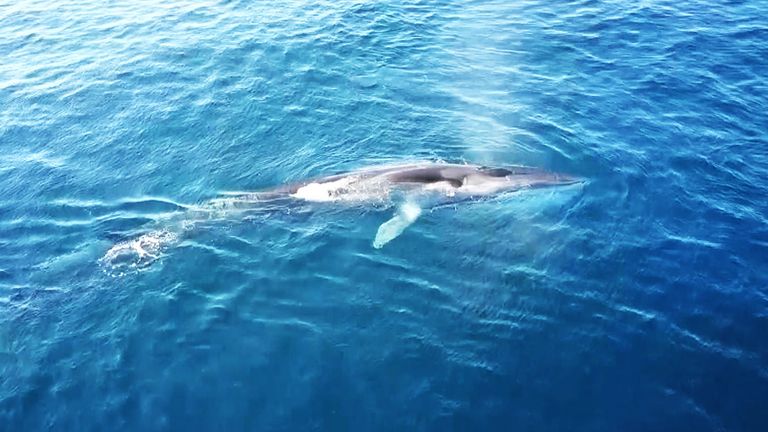[ad_1]
Scientists are using cutting-edge DNA techniques to piece together what the oceans were like before industrial whaling and other destructive human activity.
Researchers on the SEACHANGE project hope to provide the first benchmark of what a pristine sea really looks like, against which current conservation efforts can be judged.
The study is based on an exquisitely sensitive molecular technique that can detect DNA from different species in the environment.
It can give an indication of the variety of life – biodiversity – in any one place. But scientists hope it can also give an estimate of relative population sizes too.
Read more:
First ever global map of whale migration exposes growing dangers along superhighways
Could new technology save whales from ship strikes?
Sky News first filmed with the team on the Antarctic Peninsula, where they removed columns of mud from the seabed with the help of British Antarctic Survey.
Buried in the sediment are DNA signatures of marine life in the water above.
And the deeper down the mud column the scientists go, the further back in time it takes them.
By rewinding the clock with the environmental-DNA analysis, they should be able to reconstruct the richness of life in the ocean before industrial whaling started in Antarctica in the early 1900s.
Professor James Scourse of the University of Exeter, who is leading the project, said: “This is really novel. It’s not been done before.”
Some estimates suggest 1.3 million whales were slaughtered around the continent during the 20th Century.
But paper records are poor and the scientists are hoping the DNA archive in marine sediment may provide a better gauge of what the oceans used to be like.
“Suddenly there are fewer whales and that will have knock on effects right the way through the ecosystem,” said Prof Scourse.
The population of krill, tiny shrimp-like creatures that many species of whale feed on, is likely to have exploded, with further impacts in the rest of the marine food chain.
The first, unpublished, results from the DNA analysis, which is being done by colleagues at the University of Copenhagen, have revealed that in one Antarctic fjord there was a crash in the number of species between 30 and 40 years ago – for so far unknown reasons.
Prof Scourse said: “The history is beginning to come alive because we are getting the first data.
“The fact we have a significant change at a particular point in time is a heartening result.
“It shows that in a broad-brush kind of way we are able to reconstruct something meaningful about the ocean system.
“We know when industrial whaling started. We also know we have sediment that covers that transition and now we know we have the techniques to interrogate it.
“So it’s only a matter of time before we have the results.”
The SEACHANGE team, funded by the European Research Council, has recently returned from an expedition to take sediment samples off the Scottish, Norwegian and Icelandic coasts.
Professor Callum Roberts, also from the University of Exeter, said: “In developing detailed, dated time-series of ocean ecosystem change, we expect to be able to detect the earliest signs of human influence on the sea.
“And by understanding how the seas of today are different from the past, we will be able to better manage them for the future.”
[ad_2]


